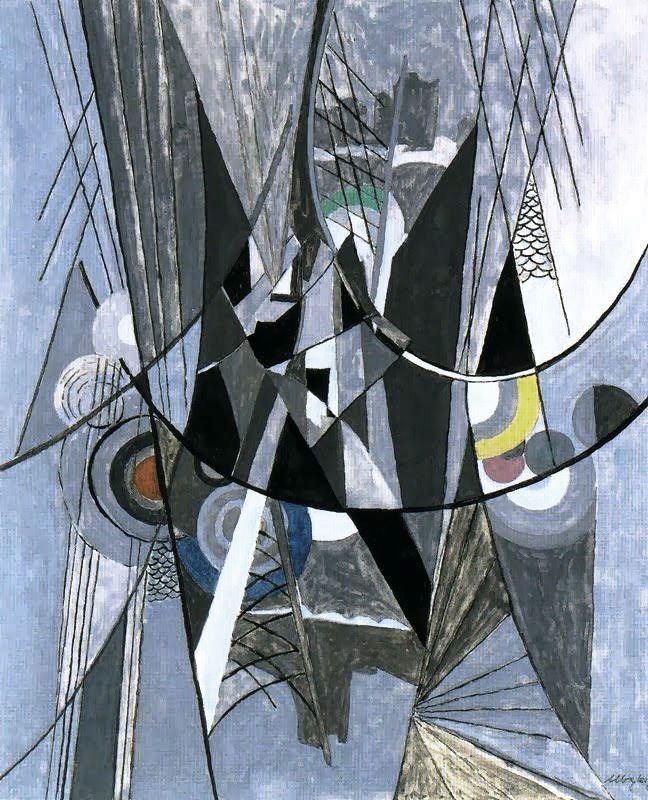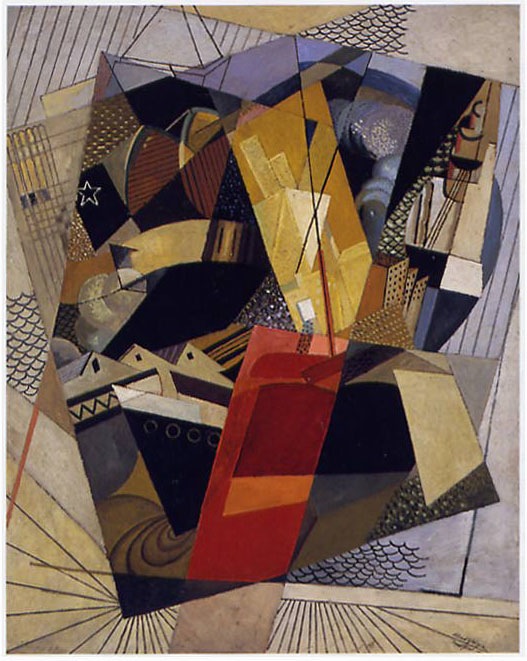LESSONS OF CUBISM
Let us first of all remember the terms in which Gleizes was later to summarise the overall development of Cubism. He says that it was an attempt to recover the sense of 'form' which had been lost in Impressionism and that it passed through three phases. The first was based on volume – hence the 'cube'; the second on the multiplicity of perspective points (the 'total image'); and the third on the affirmation of the real nature of the area that was to be covered with paint – the flat surface. (18)
(18) This argument is developed particularly, and with illustrations, in The Epic which can be found elsewhere in the present section of my website. See also Gleizes's account in Art et religion.
It is easy to identify what is specific in each of these periods; but we know that in reality none of them, at least in Gleizes' own work of the Cubist period, are ever found in a pure state unmixed with considerations that belong to the others. If paintings such as the Portrait de Jacques Nayral, the Paysage de Meudon or Les Baigneuses, clearly belong to the period of 'volume', the affirmation of the volume produces a multitude of facets which, so to speak, point the eye in different directions, thus giving an effect of multiple perspective.
Little by little, the single point perspective which still dominates the scene taken as a whole recedes in importance and the dispersion of the view through a multitude of perspective points takes over. We are reminded of the passage in Du "Cubisme' in which the painters talk of two principles dominating the construction of the painting: one in which everything is grouped round a common centre, and another which wants 'to give the properties of each part their independence, the plastic continuum must be broken up into a thousand surprises of fire and of shadow'. But as the principle of multiple perspective takes over, the paintings are held together by great lines or divisions which cover the whole area of the canvas and which, in their turn, convey an impression of flatness, reinforcing the two dimensional character of the work. This begins to be seen in Le Dépiquage des Moissons and becomes more methodical and explicit in La Ville et le Fleuve or in Les Couseuses. So the movement in three dimensions of the multiple perspective is combined with a movement in two dimensions. That is where Gleizes had arrived in 1912-13 and where he still was in 1914-15, in a tension maintained, often with quite astonishing skill, between the movement of the eye round the canvas (in two dimensions) and the movement of the eye which penetrates into the canvas (in three dimensions, but in a much more complex and diverse manner than is possible in the technique of single point perspective).
At the beginning of his stay in New York, Gleizes is still using these same means, developed just before the war and continued in the garrison at Toul, a multiple perspective in which the possibilities inherent in the flat surface are also powerfully present – a tension between the three dimensions and the two dimensions. But, under the pressure of 'l'énorme Broadway', the equilibrium is in danger of breaking. Now he seems to be using means which, only a short time previously, he had condemned in the work of Picasso and Braque and in the Italian Futurists.
In 'Le Cubisme et la Tradition', for example, published in February 1913 in the journal Montjoie!, Gleizes said, referring to Cézanne: 'he foresaw that the study of elementary volumes would open unheard of possibilities, he felt in advance that plastic dynamism had nothing to do with the movement that animates our streets, our machines, our factories' And the same idea can be found in Du "Cubisme" where Gleizes and Metzinger criticise those – probably the Futurists – 'who confound plastic dynamism with the noise of the streets'. According to 'Le Cubisme et la Tradition', this 'dynamisme plastique' is derived from rhythmic relations established between the different parts of the canvas 'juxtaposed - and not superposed as some would like us to believe' Here he is probably thinking of the work of Picasso and Braque in which, especially in the 'hermetic' period (1911), there is a great spatial ambiguity brought about through the superposition of transparent planes, in such a way that it is difficult to tell how the different elements relate, and what role each has to play in the overall construction. Gleizes disliked this method, which he called 'impressionisme de forme'. (19) The hermetic paintings of Picasso and Braque had in Gleizes' eyes fallen back into the nebulosity and formlessness of the Impressionists. (20)
(19) In L'art et ses représentants - Jean Metzinger. An English translation can be found in the Du "Cubisme section of the present website.
(20) The papiers collés are of course another outstanding example of superposition not juxtaposition (in this case an opaque superposition) which ultimately, via the work of Juan Gris and Jean Metzinger has, as I argue in For and against the twentieth century a major influence on Gleizes's thinking.
But now, under the impact of the superhuman scale of New York and of the transparency of its neon signs and shopwindows, he himself is painting planes super-imposed on each other in a way that quite resembles Picasso and Braque; and, like Picasso and Braque, he is incorporating fragments of letters into his paintings; and an unsympathetic critic could well complain that in turning to the spectacle of New York Gleizes may well be confounding 'le dynamisme plastique avec le fracas de la rue.'
Yet it is in these works, throughout the whole period of 1915-17, that we begin to see clearly in Gleizes' work the turning of the planes to the right and to the left which will soon appear under the names 'translation' and 'rotation' as the basis of all his teaching from 1922 onwards. (21)
(21) This arrangement appears for the first time in the work of Picasso and, more especially, Braque in 1911-12. It is developed further by the painters supported by Léonce Rosenberg during the war, especially by Metzinger and Gris. In the introduction I wrote for Severini's Du Cubisme au Classicisme I mention that in articles written during the war, Severini, who was at the time part of the Metzinger-Gris circle, uses the terms 'translation' and 'rotation' with more or less the same meaning as Gleizes would later give them.
Gleizes does not continue very long in the state of apparent chaos which characterises his first New York period. Very quickly, around the beginning of 1916, he organises these transparent and superimposed planes in a much more rigorous formal manner so that all the details, which remain quite distinct and clearly indicated, are now tied up in a simple geometrical structure. This has the effect of reinforcing the flat, two dimensional, nature of the canvas. Very importantly for the future we now begin to see, still in a very unmethodical and approximate manner, that the smaller shapes that go to make up the structure of the painting derive logically from the larger shapes that contain them. This will be the very essence of his painting from the 1920s onwards and it is not by accident that in Kubismus, written between 1925 and 1928, it is a painting from this period (a Bateau de Picabia - see the section of this article on Duchamp and Picabia. See also, elsewhere on the present site, the illustrations to The Epic) that Gleizes uses to illustrate the third stage of Cubism – the flat surface – as it appears in his own work.
Given the sheer ambition and exuberance of the works of this period, we can understand how Gleizes could have believed that he was going through a very important period of development and that he was on top of his form. Which helps to explain the almost triumphant tone of his letter to Barzun, in which he expresses a certain disdain for: 'l'Albert Gleizes d'hier': 'The little researches in which my desire to expand myself was wasted [it is difficult to believe that he is talking about le Dépiquage des Moissons!], I have transformed them into something more universal, more synthetic. I have become conscious of the planet. The limited horizon which I thought was the only horizon is finally opened up and stands revealed. I look with a little scorn on the Albert Gleizes of yesterday, and a little pity, for the credulity which, finally, only ended up in a narrow sectarianism’ (a spirit of sectarianism which, he suggests, on a larger scale, had been responsible for the war).

Brooklyn Bridge, 1917
Gouache on paper, 28 x 21 cm
Present whereabouts unknown
(The large scale oil of this painting in the Solomon R.Guggenheim museum has some suspicious looking grey arabesques probably added in the 1930s.)

Dans le port, 1917
Oil and sand on card, 153.3 x 120.6
Madrid, Musée Thyssen-Bornemisza
So he now believes that he possesses the means to bring about a synthesis, to 'crystallise' (22) a vision which could be called 'planetary' or 'global' but which could not yet, at least in Gleizes' later understanding of the word, be called 'universal'. And what are those means? They are means which greatly resemble those which we find again in his mature work of the 1930s and 1940s: the game of planes, presented brutally as rectangles (something he has carefully avoided prior to the New York period) and of curves, clearly presented as segments of circles, also presented in a raw state in a way that recalls his friend Robert Delaunay (and we may remark that he was in contact with Delaunay during his visit to Spain).
(22) Christopher Green - eg in Cubism and its enemies, 1987, pp.25-37 - has called the Cubism which his friends were developing in Paris at the same time 'Crystal Cubism'.